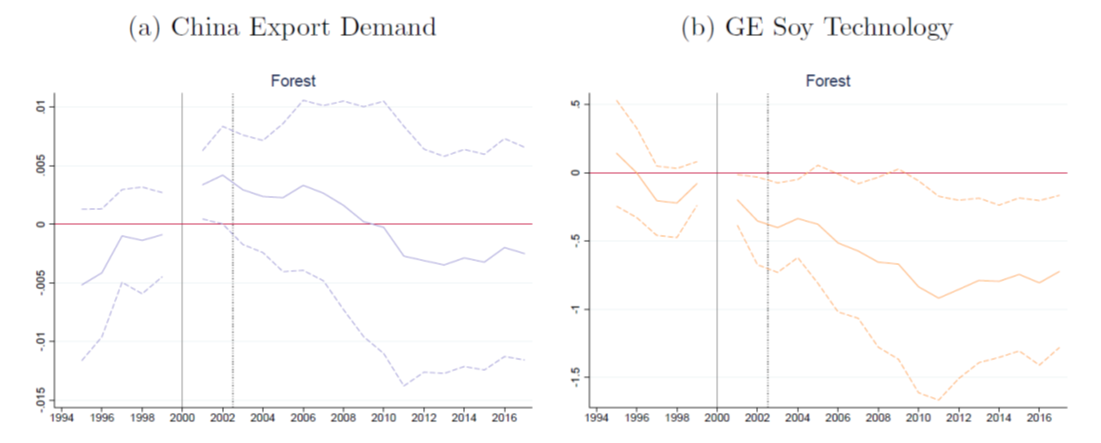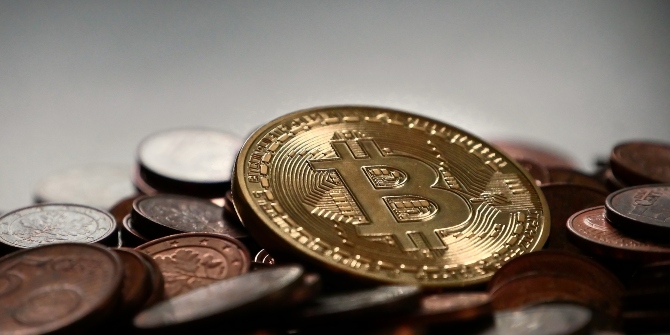Tropical ecosystems house an immense biomass, which makes it imperative to understand how they are affected by technology and trade. Igor Carreira, Francisco Costa and João Paulo Pessoa examine the Brazilian rainforest’s exposure to genetically engineered soybeans and increased demand from China between 1995 and 2017. They find that it was the comparative advantage gains in soybean production that accelerated deforestation in the period.
Francisco Costa will be presenting this work on Wednesday 13 September at 9.30am
In today’s globalised world, technology and trade are key driving forces shaping agricultural markets worldwide. These factors play a pivotal role in promoting food security and economic development, particularly in low- and middle-income countries (World Bank, 2008; Barrett, 2010). However, while technology and trade bring undeniable benefits, agriculture remains the primary driver of tropical forest loss and a major source of greenhouse gas emissions outside developed economies (IPCC, 2007; Curtis et al, 2018).
This article delves into the intricate relationship between trade and technology in agriculture, aiming to shed light on how they distinctly affect deforestation. To explore this, we focus on the case of Brazil. With its vast rainforests and burgeoning agricultural sector, Brazil serves as an illuminating case study. In particular, we examine the effects of local exposure to genetically engineered soy seeds and increased demand from China on deforestation and land use between 1995 and 2017.
Understanding the environmental footprint
Tropical ecosystems, such as the Amazon rainforest, house an immense biomass. When these ecosystems are converted into agricultural land, carbon dioxide is released into the atmosphere, contributing to climate change (Baccini et al., 2012; Araujo et al., 2020; Balboni et al., 2023). Therefore, it is imperative to comprehend the environmental impact of new agricultural technologies and trade within these sensitive ecosystems.
The impact of increased agricultural productivity on deforestation is theoretically ambiguous (Jayachandran, 2021). Greater productivity makes agriculture more profitable, leading to the expansion of agriculture into forested areas. However, higher productivity can lead to production intensification, reducing the need for new agricultural land. Evidence on these hypotheses is mixed. Some studies indicate that productivity can reduce deforestation. For instance, Abman and Carney (2020) and Abman et al. (2020) demonstrate that agriculture extension programs in Malawi and Uganda reduced deforestation. In contrast, Hess et al. (2021) show that community-driven development programs in Gambia increased deforestation.
The environmental impact of trade is also conceptually ambiguous. Grossman and Krueger (1991) suggest that the net effects depend on a combination of factors: an increase in production scale, a change in the product mix, and the adoption of cleaner and more efficient technologies. All three mechanisms are at play in our study. Empirically, trade shocks (Cherniwchan and Taylor, 2022), international commodity price increases (Harding et al., 2021), and trade agreements (Abman and Lundberg, 2020) have been linked to deforestation, especially in tropical regions.
A complex relationship
Technology and trade are closely intertwined, making it essential to dissect their distinct impacts on deforestation (Autor et al., 2015). Trade can drive productivity by providing access to cheaper inputs and spurring innovation. Similarly, advancements in agricultural technology can alter a country’s comparative advantage, leading to specialised production and increased trade flows. Importantly, it is vital to note that the full benefits of enhanced productivity are realised only when there is sufficient domestic or international demand for the products. To fully grasp the intricacies of the issue, we must explore how new agricultural technologies and trade interact and affect deforestation.
Brazil
Our primary contribution is bridging the gap between the literatures on agriculture productivity and trade to evaluate their relative impact on expanding agricultural land at the expense of forests. To do this, we rely on quasi-exogenous measures of local exposure to agricultural technological innovations and increased demand from China. We focus on the case of Brazil, a nation that has witnessed significant agricultural growth in the last decades propelled by two key forces.
First, genetically engineered soy seeds – first commercialised in Brazil in 2003 – not only offered higher yields but also made it feasible to grow soybeans in the warmer regions of the country (Bustos et al., 2016; Pellegrina, 2022). A second large economic event that had a profound influence on the Brazilian agriculture sector was China’s emergence in the world market. For developing countries in general and Brazil in particular, China rapidly became a major importer of commodities (Costa et al, 2016), including but not exclusively soybeans.
The new genetically engineered soy seeds and the growing demand for soybeans were a perfect storm in Brazilian agriculture. Brazil became the leading global exporter of soybeans, with China being the largest destination of Brazilian soy production. Brazilian exports of soybeans to China increased by US$2.8 billion between 1995 and 2006, and by US$17.4 billion between 2006 and 2017. Figure 1 shows the change in land use in this period.
Figure 1. Land use trends in Brazil

Notes: These figures show the evolution of the share of forest areas, cropland, and pastureland in Brazil. Data from MapBiomas.
Differential effects across municipalities
To disentangle these channels, we rely on quasi-exogenous measures of local – at the municipality level – exposure to technological innovations and demand from China. We measure the local exposure to the increase in agricultural productivity brought by genetically engineered soy seeds by using data on potential soy yields from the Food and Agriculture Organization’s project Global-Agroecological Zones (Bustos et al., 2016). We measure local exposure to increased export demand from China using a two-step procedure based on country-level trade data (Costa et al, 2016). This procedure helps us distinguish the differential change in Chinese demand for specific products relative to the rest of the world, excluding Brazil.
Crucially, we observe variation in differential exposure to these technology and trade shocks across municipalities in the country, allowing us to study their impacts effectively. Our key identifying assumption is that, conditional on controls, differential suitability to the new genetically engineered soy seed and exposure to China-induced export demand are not correlated with other determinants of land use. We find supporting evidence for this assumption.
Distinct footprints
Our findings reveal distinct footprints for local exposure to these two phenomena. Figure 2b shows that greater local exposure to increased agricultural productivity, driven by new soy technology, is associated with accelerated deforestation. Our estimates suggest that, by 2017, a municipality at the 75th percentile of the technology shock lost about 1 percentage point of forest more than a municipality at the 25th percentile. To put that into perspective, we can look at Comodoro, a municipality in the state of Mato Grosso close to the 75th percentile and with an area of approximately 21,520 km2. Our estimates suggest that this single municipality lost about 212.6 km2 more forest area than a municipality not so exposed to the soy technology shock, the equivalent of over a quarter of the area occupied by New York City.
This result differs from recent papers that find that agricultural productivity gains can promote conservation. Unlike previous papers, we study a setting in which the new agriculture technology favours large-scale agriculture and capital constraints are loose. This is a period in which the government devoted large, subsidised credit to large agriculture producers. Different from the other settings, trade also likely plays a role here, as the soy productivity shock coincides with the global emergence of a new market – China – for the product.
As Figure 2a shows, however, there is no economically meaningful link between local exposure to increased demand from China and deforestation. This suggests that the main driver of differential expansion of cropland over forest across Brazil was not simply the increased demand from China, but the comparative advantage gains in that sector that accelerated deforestation in some regions.
Our research adds valuable insights into this intricate interplay, highlighting the importance of nuanced analyses in the context of agricultural development and conservation.
Figure 2. Estimated effects of local exposure to Chinese demand and GE soy seed

Notes: These figures show the estimates of the effects of the Chinese demand (a) and GE soy technology (b) on land-use change spillovers over time. The solid lines plot the point estimates and the dashed lines the 95% confidence. The points to the right of the solid vertical line consider post-trade shock regressions (2001 onwards), while points to the right of the dashed vertical line consider post-trade and technology shocks regressions (2003 onwards). Please refer to Figure 3 in the paper for complete specification.
- This blog post is based on The Deforestation Effects of Trade and Agricultural Productivity in Brazil. It will be presented at LSE Environment Week.
- The post represents the views of its authors, not the position of LSE Business Review or the London School of Economics.
- Featured image provided by Shutterstock
- When you leave a comment, you’re agreeing to our Comment Policy.






